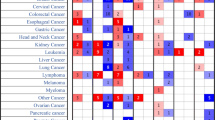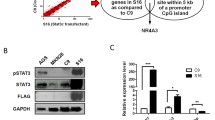Abstract
Background
Molecular mechanisms behind the oncogenesis of gastric cancer (GC) have yet to be identified.
Methods
A novel candidate tumor-suppressor gene, which is also associated with inhibition of epidermal growth factor (EGF), was sought by means of double combination array analysis for use as a prognostic marker of GC. This consisted of expression array and single nucleotide polymorphism array analysis, along with a literature search. Cancerous and noncancerous tissues from an 82-year-old man with GC were analyzed simultaneously.
Results
The expression array and literature search identified that the suppressor of cytokine signaling 4 (SOCS4), a negative feedback regulator of EGF signaling, had significantly attenuated expression in tumor tissue. Although chromosomal deletion was not found at 14q22 where SOCS4 is located, numerous CpG sites were observed in the promoter region of the SOCS4 gene. Several GC cell lines showed reactivation of SOCS4 mRNA expression after treatment with 5-aza-2′-deoxycytidine. Using surgically resected specimens, we found that 40 of 50 (80%) tumor tissues exhibited promoter hypermethylation of the SOCS4 gene. Consequently, SOCS4 expression in tumor tissues was significantly weaker than in noncancerous counterparts (P < 0.0001). In the survival analysis, SOCS4 hypermethylation was associated with a poor prognosis of GC patients (P = 0.0320).
Conclusions
Double combination array analysis suggested that SOCS4 could be a novel candidate for further exploration as a tumor-suppressor gene in GC. Hypermethylation was the mechanism by which SOCS4 was silenced and was implicated in the development of GC. SOCS4 methylation might be an informative marker in predicting the prognosis.






Similar content being viewed by others
References
Parkin DM, Bray F, Ferlay J et al (2002) Global cancer statistics. CA Cancer J Clin 55:74–108
Knuutila S, Björkqvist AM, Autio K et al (1998) DNA copy number amplifications in human neoplasms: review of comparative genomic hybridization studies. Am J Pathol 152:1107–1123
Myllykangas S, Junnila S, Kokkola A et al (2008) Integrated gene copy number and expression microarray analysis of gastric cancer highlights potential target genes. Int J Cancer 123:817–825
Chen CN, Chang CC, Su TE et al (2009) Identification of calreticulin as a prognosis marker and angiogenic regulator in human gastric cancer. Ann Surg Oncol 16:524–533
Tay ST, Leong SH, Yu K et al (2003) A combined comparative genomic hybridization and expression microarray analysis of gastric cancer reveals novel molecular subtypes. Cancer Res 63:3309–3316
Yang S, Jeung HC, Jeong HJ et al (2007) Identification of genes with correlated patterns of variations in DNA copy number and gene expression level in gastric cancer. Genomics 89:451–459
Tsukamoto Y, Uchida T, Karnan S et al (2008) Genome-wide analysis of DNA copy number alterations and gene expression in gastric cancer. J Pathol 216:471–482
Nomoto S, Kanda M, Okamura Y et al (2010) Epidermal growth factor-containing fibulin-like extracellular matrix protein 1, EFEMP1, a novel tumor-suppressor gene detected in hepatocellular carcinoma using double combination array analysis. Ann Surg Oncol 17:923–932
Okamura Y, Nomoto S, Kanda M et al (2010) Leukemia inhibitory factor receptor (LIFR) is detected as a novel suppressor gene of hepatocellular carcinoma using double-combination array. Cancer Lett 289:170–177
Kanda M, Nomoto S, Okamura Y et al (2009) Detection of metallothionein 1G as a methylated tumor suppressor gene in human hepatocellular carcinoma using a novel method of double combination array analysis. Int J Oncol 35:477–483
Raghavan M, Lillington DM, Skoulakis S et al (2005) Genome-wide single nucleotide polymorphism analysis reveals frequent partial uniparental disomy due to somatic recombination in acute myeloid leukemias. Cancer Res 65:375–378
Teh MT, Blaydon D, Chaplin T et al (2005) Genomewide single nucleotide polymorphism microarray mapping in basal cell carcinomas unveils uniparental disomy as a key somatic event. Cancer Res 65:8597–8603
Yokoyama H, Ikehara Y, Kodera Y et al (2006) Molecular basis for sensitivity and acquired resistance to gefitinib in HER2-overexpressing human gastric cancer cell lines derived from liver metastasis. Br J Cancer 95:1504–1513
Kennedy GC, Matsuzaki H, Dong S et al (2003) Large-scale genotyping of complex DNA. Nat Biotechnol 21:1233–1237
Nannya Y, Sanada M, Nakazaki K et al (2005) A robust algorithm for copy number detection using high-density oligonucleotide single nucleotide polymorphism genotyping arrays. Cancer Res 65:6071–6079
Larsen L, Ropke C (2002) Suppressors of cytokine signaling: SOCS. APMIS 110:833–844
Cooney R (2002) Suppressors of cytokine signaling (SOCS): inhibitors of the JAK/STAT pathway. Shock 17:83–90
Golub TR, Slonim DK, Tamayo P et al (1999) Molecular classification of cancer: class discovery and class prediction by gene expression monitoring. Science 286:531–537
Okabe H, Satoh S, Kato T et al (2000) Genome-wide analysis of gene expression in human hepatocellular carcinoma using cDNA microarray: identification of genes involved in viral carcinogenesis and tumor progression. Cancer Res 61:2129–2137
El-Rifai W, Frierson HF Jr, Harper JC et al (2001) Expression profiling of gastric adenocarcinoma using cDNA array. Int J Cancer 92:82–88
Wang DG, Fan JB, Siao CJ et al (1998) Large-scale identification, mapping and genotyping of single-nucleotide polymorphisms in the human genome. Science 280:1077–1082
Zhao X, Li C, Paez JZ et al (2004) An integrated view of copy number and allelic alterations in the cancer genome using single nucleotide polymorphism arrays. Cancer Res 64:3060–3071
Bignell GR, Huang J, Greshock J et al (2004) High-resolution analysis of DNA copy number using oligonucleotide microarrays. Genome Res 14:287–295
Starr R, Willson T, Viney E et al (1997) A family of cytokine-inducible inhibitors of signalling. Nature 387:917–921
O’Sullivan LA, Liongue C, Lewis RS et al (2007) Cytokine receptor signaling through the Jak-Stat-Socs pathway in disease. Mol Immunol 44:2497–2506
Yoshikawa H, Matsubara K, Qian GS et al (2001) SOCS-1, a negative regulator of the JAK/STAT pathway, is silenced by methylation in human hepatocellular carcinoma and shows growth-suppression activity. Nat Genet 28:29–35
Fukushima N, Sato N, Sahin F et al (2003) Aberrant methylation of suppressor of cytokine signalling-1 (SOCS-1) gene in pancreatic ductal neoplasms. Br J Cancer 89:338–343
Fujitake S, Hibi K, Okochi O et al (2004) Aberrant methylation of SOCS-1 was observed in younger colorectal cancer patients. J Gastroenterol 39:120–124
Oshimo Y, Kuraoka K, Nakayama H et al (2004) Epigenetic inactivation of SOCS-1 by CpG island hypermethylation in human gastric carcinoma. Int J Cancer 112:1003–1009
To KF, Chan MW, Leung WK et al (2004) Constitutional activation of IL-6-mediated JAK/STAT pathway through hypermethylation of SOCS-1 in human gastric cancer cell line. Br J Cancer 91:1335–1341
Galm O, Yoshikawa H, Esteller M et al (2003) SOCS-1, a negative regulator of cytokine signaling, is frequently silenced by methylation in multiple myeloma. Blood 101:2784–2788
He B, You L, Uematsu K et al (2003) SOCS-3 is frequently silenced by hypermethylation and suppresses cell growth in human lung cancer. Proc Natl Acad Sci USA 100:14133–14138
Weber A, Hengge UR, Bardenheuer W et al (2005) SOCS-3 is frequently methylated in head and neck squamous cell carcinoma and its precursor lesions and causes growth inhibition. Oncogene 24:6699–6708
Storojeva I, Boulay JL, Ballabeni P et al (2005) Prognostic and predictive relevance of DNAM-1, SOCS6 and CADH-7 genes on chromosome 18q in colorectal cancer. Oncology 68:246–255
Lai RH, Hsiao YW, Wang MJ et al (2010) SOCS6, down-regulated in gastric cancer, inhibits cell proliferation and colony formation. Cancer Lett 288:75–85
Kario E, Marmor MD, Adamsky K et al (2005) Suppressors of cytokine signaling 4 and 5 regulate epidermal growth factor receptor signaling. J Biol Chem 280:7038–7048
Citri A, Yarden Y (2006) EGF-ERBB signalling: towards the systems level. Natl Rev Mol Cell Biol 7:505–516
Gotoh N (2009) Feedback inhibitors of the epidermal growth factor receptor signaling pathways. Int J Biochem Cell Biol 41:511–515
Bullock AN, Rodriguez MC, Debreczeni JE et al (2007) Structure of the SOCS4-ElonginB/C complex reveals a distinct SOCS box interface and the molecular basis for SOCS-dependent EGFR degradation. Structure 15:1493–1504
Conflict of interest
We do not have any commercial interest or sources of financial or material support to report.
Author information
Authors and Affiliations
Corresponding author
Rights and permissions
About this article
Cite this article
Kobayashi, D., Nomoto, S., Kodera, Y. et al. Suppressor of Cytokine Signaling 4 Detected as a Novel Gastric Cancer Suppressor Gene using Double Combination Array Analysis. World J Surg 36, 362–372 (2012). https://doi.org/10.1007/s00268-011-1358-2
Published:
Issue Date:
DOI: https://doi.org/10.1007/s00268-011-1358-2




